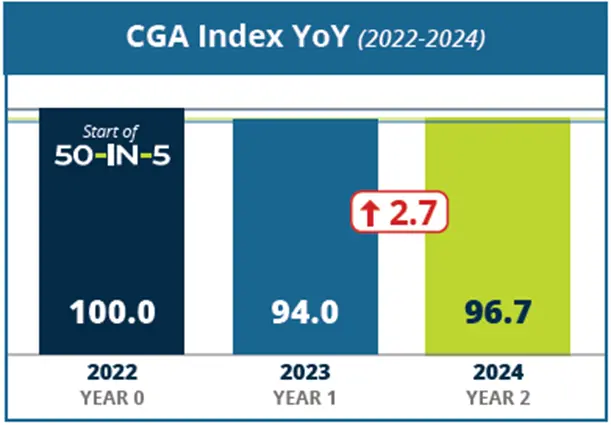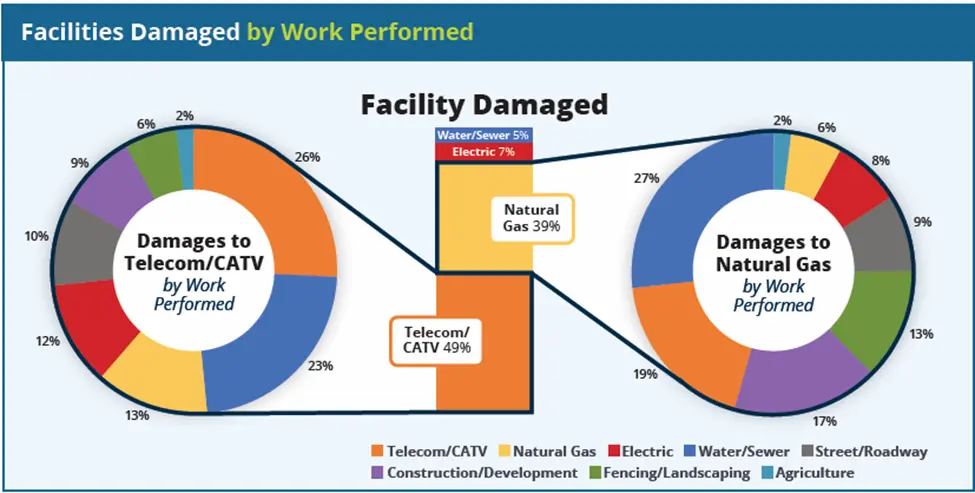This is the start of a multi-part series focusing on the findings, recommendations, and potential impacts of the Common Ground Alliance’s 2024 DIRT Report.
Ending exemptions for water and sewer asset holders, renegotiating One Call contracts based on performance instead of cost, and enacting mandatory preconstruction protocols for telecommunication infrastructure installation are just some of the changes the Common Ground Alliance is urging to combat excavation utility damages nationwide.
The CGA’s 2024 DIRT Report includes the strongest language the trade association of nearly 4,000 damage prevention professionals has ever used regarding compliance with federal and state 811 regulations, and safety practices, and for good reason.
“We are falling critically short of the progress necessary to drive real change,” the letter from President & CEO Sarah Magruder Lyle at the front of the report states.
“After encouraging progress in 2023, the 2024 data shows an increasing trend of total damages, with the CGA Index rising from 94 to 96.7… our current trajectory will not achieve the transformative change our industry needs without commitment and immediate investment.”

What is the CGA Index?
In 2023, for the 2022 reporting year, the CGA instituted a new scale of metrics designed to provide a clearer picture of how utility damages occurred, in what business sectors, and what factors caused the damages. The organization shows a 2.3 point increase in full dataset quality, which could potentially signal that the more accurate the reporting and metrics become, the larger and more dangerous the problem of underground utility strikes actually is.
What Are the Main Causes of Utility Damages?
Of the 196,977 unique damage reports covered in the 2024 report (combined total of the U.S. and Canada) 85% of all utility damages were caused by the “top 10 root causes.”
1. Failure to file a locate request
2. Excavators verifying marks but failing to maintain clearances
3. Facilities unmarked due to locator error
4. Facilities inaccurately marked due to locator error
5. Improper excavation practices (not otherwise listed)
6. Excavation proceeding without marking verification via potholing
7. No mark-out due to unresponsive utility operator or contract locator
8. Failure to shore excavation support/facilities
9. Faded, lost, or unmaintained mark-outs
10. Unmarked facilities due to incorrect existing records/maps
In 38% of reported incidents, excavators had followed the rules of their state’s reporting system, but were unable to break ground safely, if at all, because their locate request had an “incomplete response.”
And the top 10 root causes “reveal clear patterns” showing that utility work “dominates” damage incidents across all root causes.

In the Executive Summary for the 2024 report, the CGA lays out specific training, industry, and “regulatory frameworks that balance deployment speed with safety,” to meet the moment. “…we must fundamentally shift our approach form voluntary Best Practices adoption to consistent, enforceable standards and forward-thinking Next Practice innovation,” they say on page 6.
Their rallying cry is “The Path Forward Requires Systemic Change,” and is broken into five main priorities, each with its own specific recommendations for regulators and policymakers, facility owners, and excavators.

Priority 1: Improve Locate Timelines Across All Operators to Target Top Damage Root Cause
Priority 2: Target Water/Sewer and Telecommunications Dominance in Work Performed
Priority 3: Scale Successful Programs Based on Damage Prevention Institute Findings
Priority 4: Implement Systematic Enforcement Across All Stakeholders
Priority 5: Accelerate Data-Driven Decision-Making
Why is the CGA Sounding the Alarm Now?
While this is not the first time the Common Ground Alliance has called for legislation and regulatory oversight of the nation’s One Call/811 systems, the 2024 DIRT Report contains the organization’s most strident and comprehensive call to action in memory.
In its 2022 report, the CGA urged a reset of the enforcement and penalty structure, stating that stakeholders should “examine enforcement of all primary participants in the process to ensure penalties are effective and incentivize those involved to change their behavior.” Further, they asked that accountability extend to asset owners, excavators, and utility locators.
Again, in 2023, the DIRT Report framed the organization’s recommendations in the form of industry actions and called on stakeholders to “establish coordination mechanisms between government agencies/regulators, facility owners, excavators, locators and other industry stakeholders.” Such coordination usually requires rulemaking or statutory updates. So, in proposing mandatory standards, the CGA was looking to legislators at the city, state, and federal level, although the ask was couched in some rhetoric.
Prior to and since 2022, every update to the CGA’s Best Practices Guide & its Stakeholder Advocacy Toolkit has encouraged mandatory education either as an alternative to, or supplement of civil penalties for damage-prevention law violations, but stopped short of direct calls for legislative change.
Now, the gloves have come off in 2025 with the 2024 DIRT Report’s calls for mandatory preconstruction protocols for telecommunications installations, which are often done using directional drilling/trenchless technology, and can have a massive impact on existing utilities, among other sweeping recommendations.
Future GPRS Industry Insights articles on the 2024 DIRT Report will delve into each of the CGA-named priorities, their precedents, potential regulatory steps, and overall impacts on the construction and damage prevention industries.
GPRS has been at the cutting edge of construction damage prevention since 2001, striving to provide our customers nationwide the infrastructure data they need to bring their projects in on time, on budget, and most importantly, safely. Utility damage prevention is a cornerstone of our commitment to Visualizing The Built World®.
What can we help you visualize?



.svg)